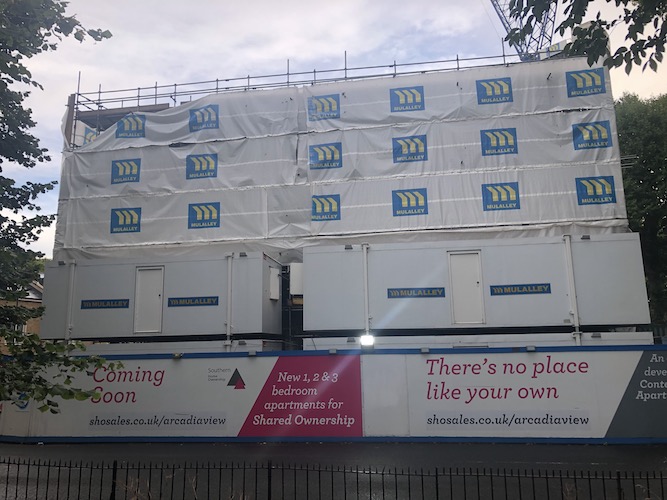The latest release of City Hall affordable housing statistics has prompted the usual political jousting: another “record-breaking” performance, or evidence of a disappointing lack of urgency on the part of the Mayor?
The figures for April to June of this year saw London Assembly Conservatives seizing on what they called a “pathetic” total of 764 affordable homes started with mayoral funding. “The housing crisis…has been almost completely ignored by Sadiq Khan. There is no sense of urgency,” said Assembly Member Tony Devenish.
Yet at the same time Sadiq Khan was trumpeting his 18,722 “starts” in the full 12 months to April as a record-breaking high since Greater London Authority records began in 2003, along with the construction of more new council homes getting underway than at any time since 1979.
What is the reality? If 764 homes started in three months looks low, it is important to recognise that those who actually build most of these homes, mainly housing associations and councils, work to annual targets agreed between City Hall and Whitehall, and their delivery is always “back-ended” and has been under successive Mayors. Last year the first quarter total was even lower, at 272 starts. Nine months later Khan’s record total for the year had been reached.
You can’t live in a “start”, though, as Khan’s opponents regularly point out. So how many homes have actually been finished for people to live in?
Under Johnson, getting on for 12,000 homes a year were completed over eight years. In Khan’s two terms to date the total is some 45,000, equating to not quite 7,500 a year. However, completions under Johnson fell from an annual average of 13,516 in his first term to 9,984 in his second. Khan’s numbers are going up, from 4,934 homes completed in his first year of office to 10, 252 last year.
The type of tenure matters too. Khan came into office with a pledge that affordable homes built under his policies would be “genuinely” so, and successful deal-making with Whitehall has seen a municipal housing boost, significantly upping the numbers of new homes available at social rent.
The government itself uses “starts” as its target because they directly reflect the Mayor’s ability to get money out of the door and spades in the ground, as opposed to reaping the rewards of their predecessor’s investment. By that measure, Khan seems to be succeeding.
Even so, it is still a race against time to get all the money spent. Khan has garnered £4.82 billion from the government to start 116,000 affordable homes by 2023, with a further £4 billion for 35,000 homes by 2026, and most of that is allocated. But some 24,000 homes need to be started to meet the 2023 deadline, with the second programme yet to get underway.
It’s a challenging target. The construction industry faces cost hikes as well as labour and skills shortages, and housebuilders are increasingly being outbid when seeking to secure scarce development sites by e-commerce warehouse developers.
Despite this, completions as well as starts are on an upward trajectory. Yet the positive trends are overshadowed by the increasingly grim overall housebuilding picture in London. The total number of new homes got underway in London in 2020/21, around 37,000, fell well short of the 52,000 a year City Hall target, never mind the estimated 66,000 new homes a year actually required to meet housing need in the capital.
London has the highest homelessness numbers in the country, with more than 60,000 households in temporary accommodation, including 76,000 children. A slump in private rental supply and asking rents up by more than 15% in the first quarter of 2022 are threatening to add to that total.
What is the answer? Partly, it is money. Current budgets may look large, but City Hall research suggests £4.9 billion a year is needed over the next ten years in order to meet this need. “The new government must work swiftly with the private sector to create new models for investment into affordable housing,” says the capital’s business grouping BusinessLDN.
The group highlights planning barriers too, particularly for City Hall plans to meet its targets through “densification” around transport hubs, often in outer London, as well as on the larger brownfield “opportunity” areas. This has triggered an ongoing “war of the suburbs”, with planning battles over Tube station car parks, former supermarket sites and even redundant gas works.
Might the new Prime Minister, embracing investment and building, sort this out? The signs aren’t encouraging. At the final hustings of the Tory leadership campaign, held at Wembley, outer London MP Iain Duncan Smith told party members that “top-down” housing targets were used by Labour councils “as an excuse to build tower blocks over low-rise family housing areas”, adding that Liz Truss had pledged to “help families living in our areas not to be dominated by tower blocks”.
And candidate Truss had clearly been listening to her London colleagues. “What I would do is abolish those targets in legislation. I would enable the London suburbs who want the family homes to build [them],” she said.
Those suburban wars look set to continue. Meanwhile, house prices and rents continue to rise.
Full statistics on City Hall-funded affordable housing starts and completions are available here.
On London strives to provide more of the kind of journalism the capital city needs. Become a supporter for just £5 a month. You will even get things for your money. Details here.

